1 2 3 How many groups


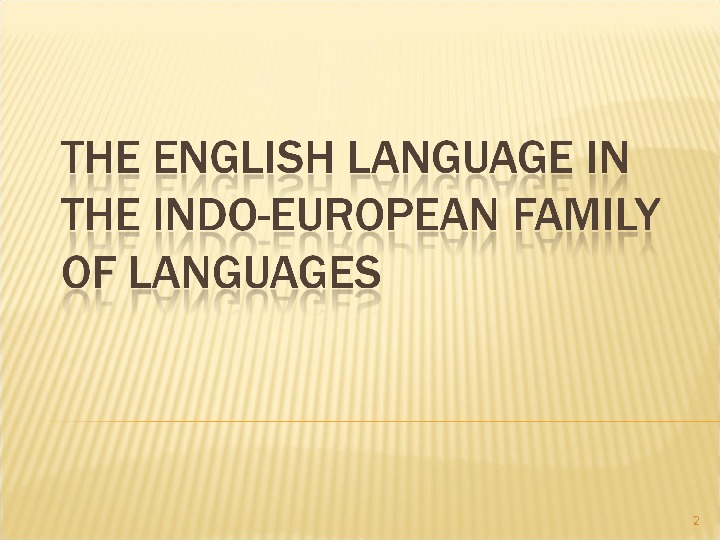
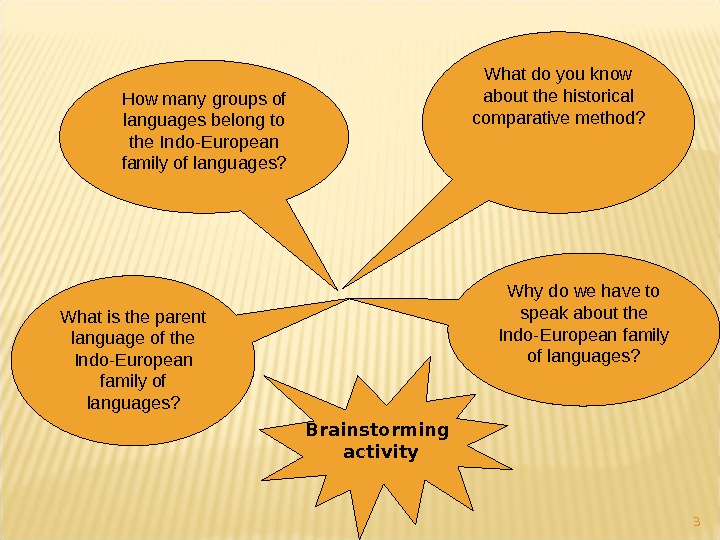
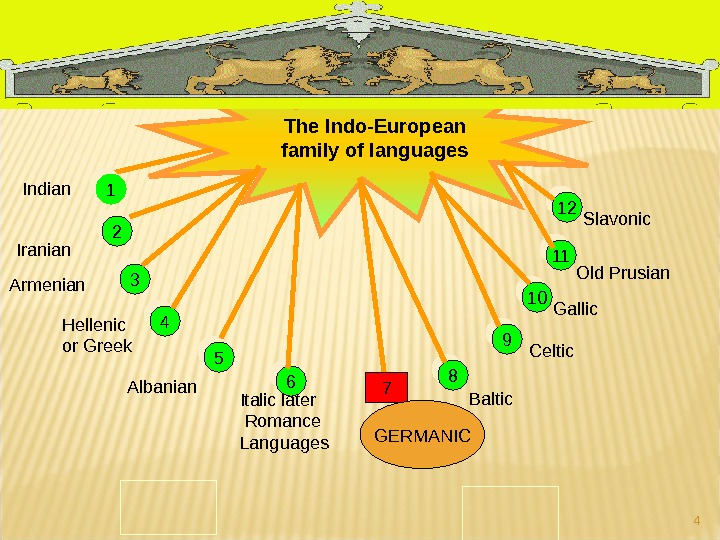
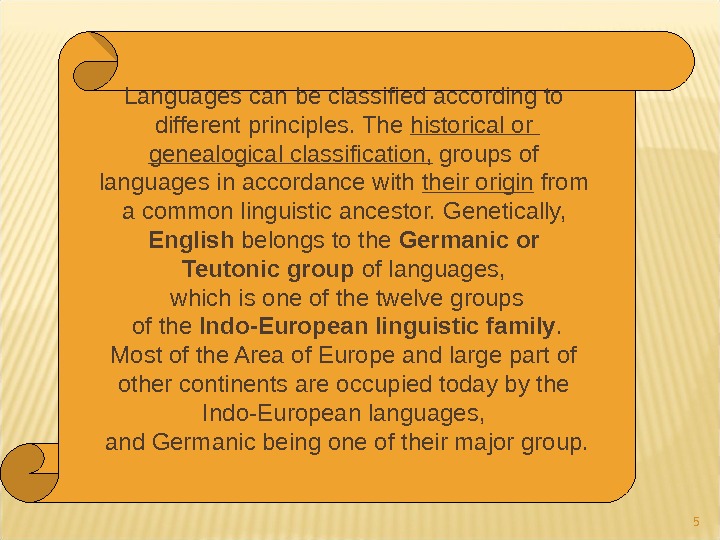
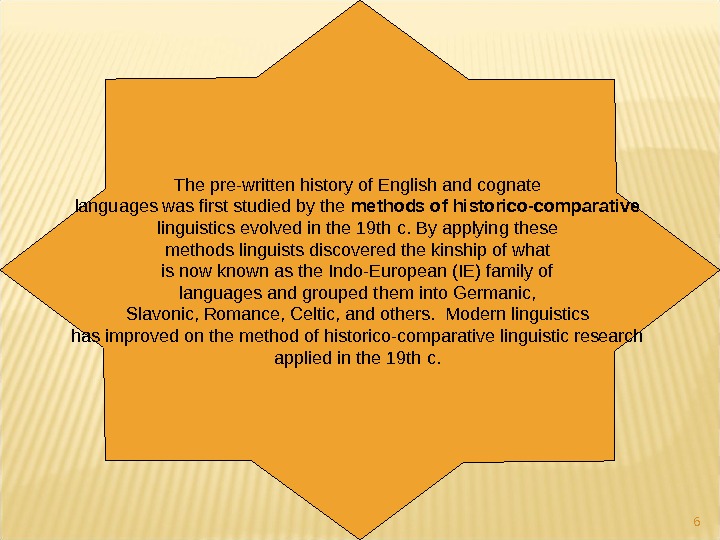
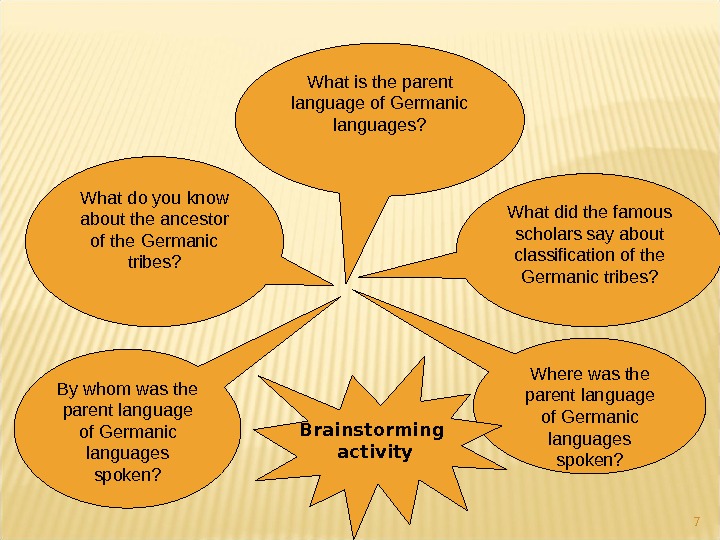
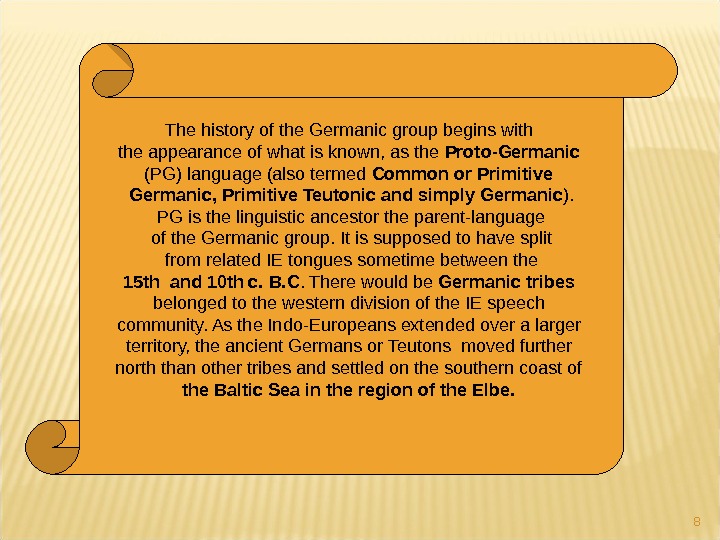
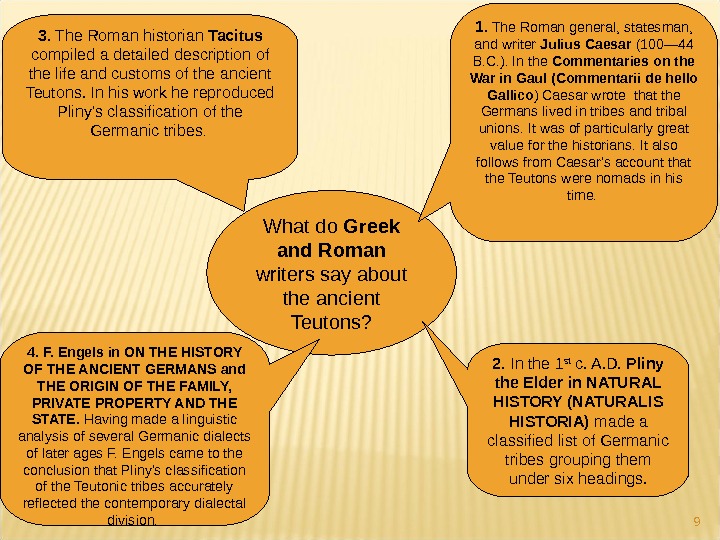
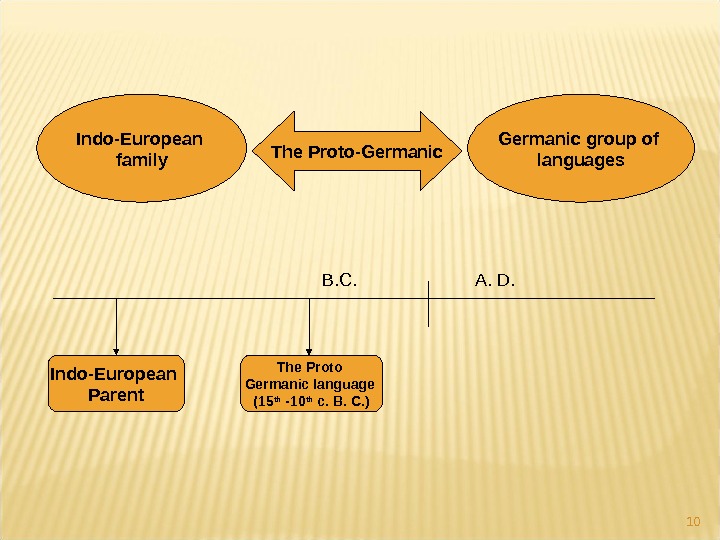
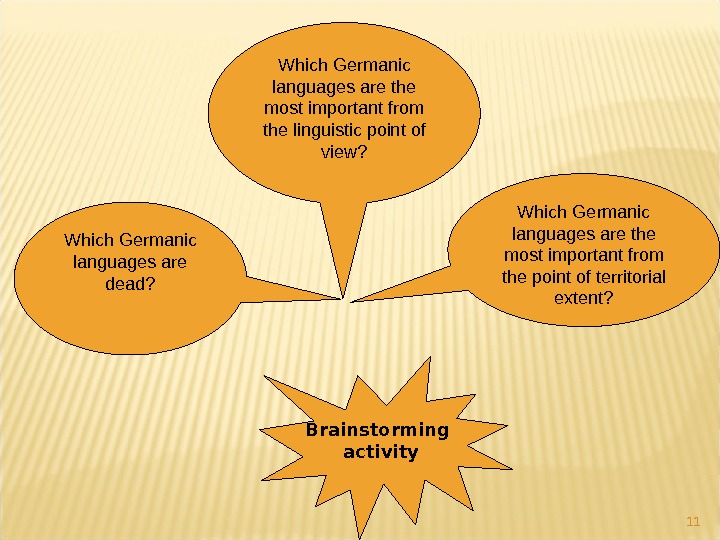
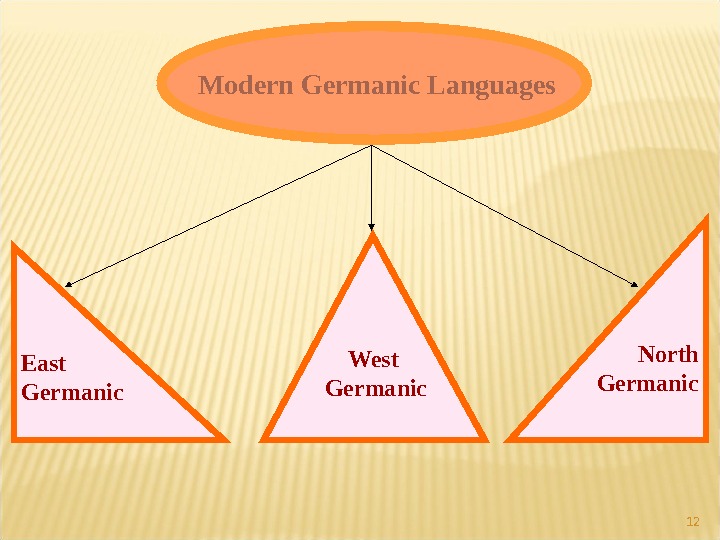
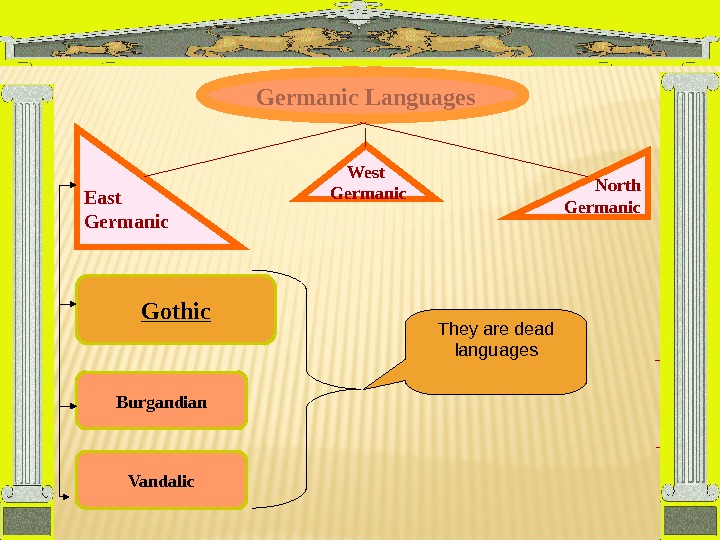
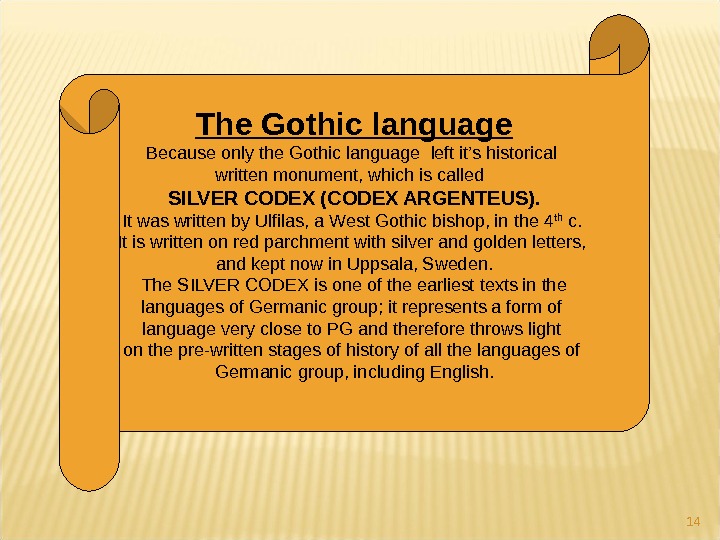
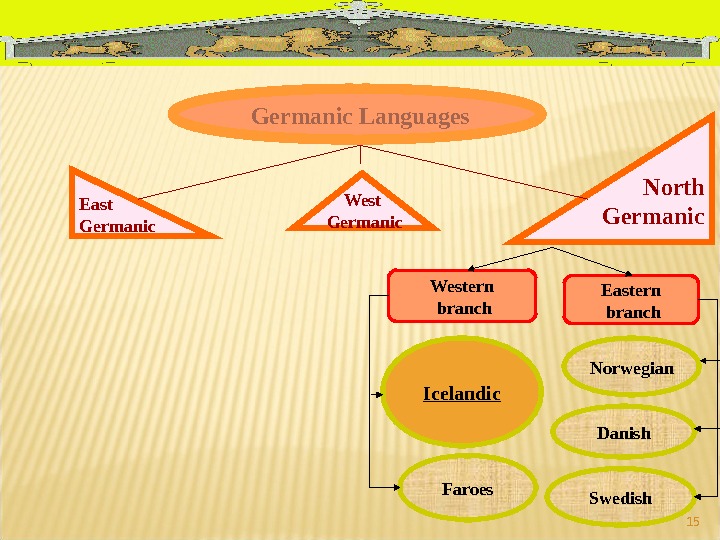
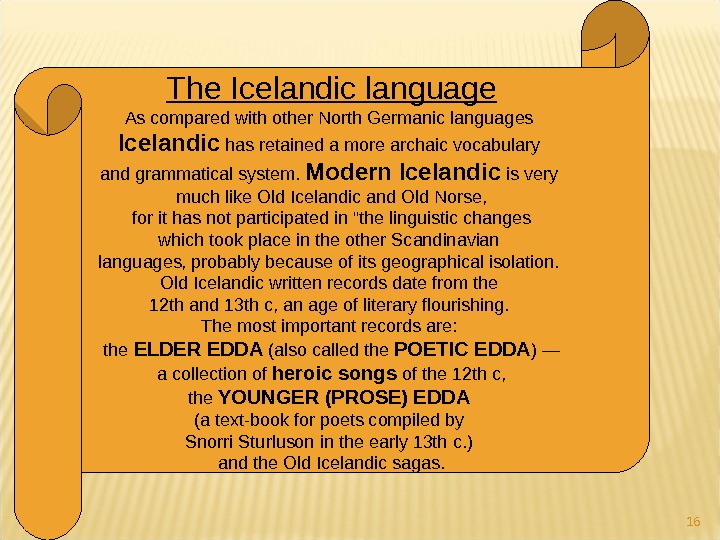
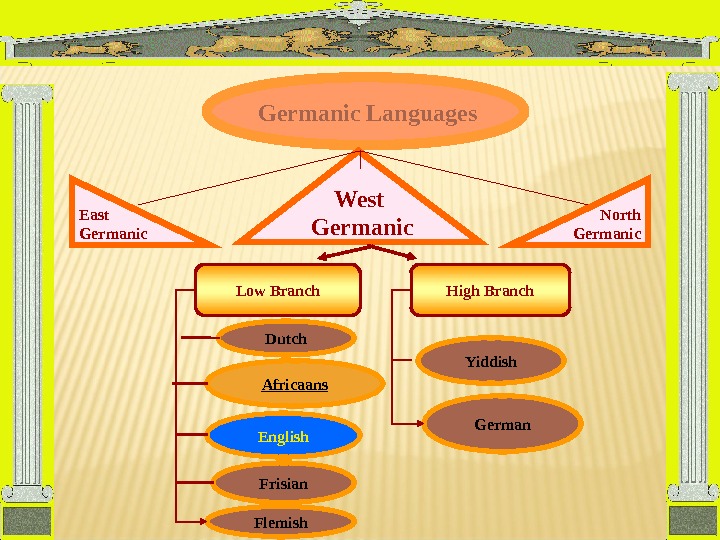

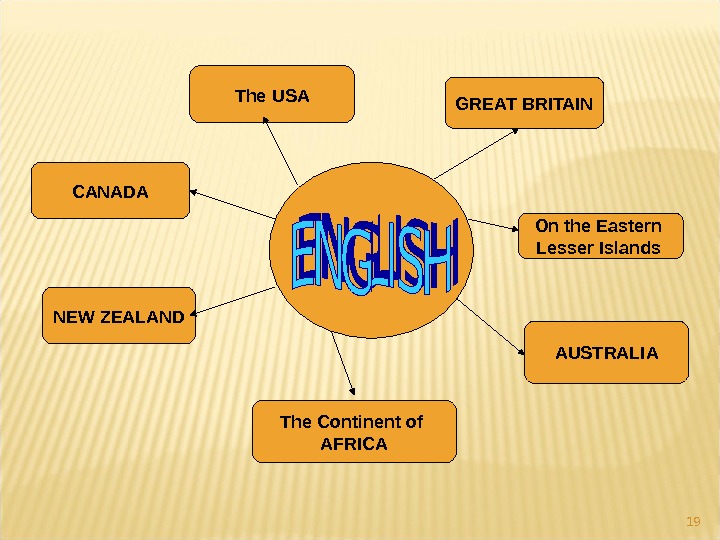
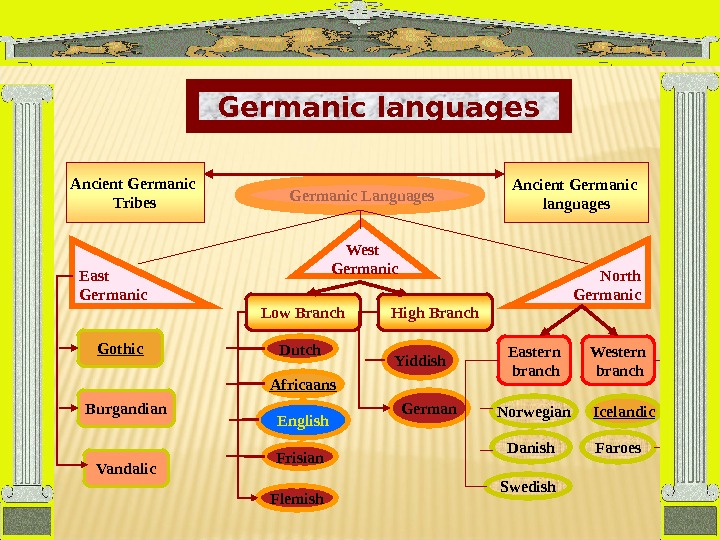
- Размер: 2.1 Mегабайта
- Количество слайдов: 20
Описание презентации 1 2 3 How many groups по слайдам


 3 How many groups of languages belong to the Indo-European family of languages? Why do we have to speak about the Indo-European family of languages? What is the parent language of the Indo-European family of languages? What do you know about the historical comparative method? Brainstorming activity
3 How many groups of languages belong to the Indo-European family of languages? Why do we have to speak about the Indo-European family of languages? What is the parent language of the Indo-European family of languages? What do you know about the historical comparative method? Brainstorming activity
 4 Albanian Baltic Celtic Gallic 2 2 3 3 4 4 5 5 6 6 8 8 9 9 10 10 11 1112 12 Italic later Romance Languages 1 1 Indian Iranian Armenian Old Prusian Slavonic Hellenic or Greek The Indo — European family of languages 7 GERMANI
4 Albanian Baltic Celtic Gallic 2 2 3 3 4 4 5 5 6 6 8 8 9 9 10 10 11 1112 12 Italic later Romance Languages 1 1 Indian Iranian Armenian Old Prusian Slavonic Hellenic or Greek The Indo — European family of languages 7 GERMANI
 5 Languages can be classified according to different principles. The historical or genealogical classification, groups of languages in accordance with their origin from a common linguistic ancestor. Genetically, English belongs to the Germanic or Teutonic group of languages, which is one of the twelve groups of the Indo-European linguistic family. Most of the Area of Europe and large part of other continents are occupied today by the Indo-European languages, and Germanic being one of their major group.
5 Languages can be classified according to different principles. The historical or genealogical classification, groups of languages in accordance with their origin from a common linguistic ancestor. Genetically, English belongs to the Germanic or Teutonic group of languages, which is one of the twelve groups of the Indo-European linguistic family. Most of the Area of Europe and large part of other continents are occupied today by the Indo-European languages, and Germanic being one of their major group.
 6 The pre-written history of English and cognate languages was first studied by the methods of historico-comparative linguistics evolved in the 19 th с. By applying these methods linguists discovered the kinship of what is now known as the Indo-European (IE) family of languages and grouped them into Germanic, Slavonic, Romance, Celtic, and others. Modern linguistics has improved on the method of historico-comparative linguistic research applied in the 19 th с.
6 The pre-written history of English and cognate languages was first studied by the methods of historico-comparative linguistics evolved in the 19 th с. By applying these methods linguists discovered the kinship of what is now known as the Indo-European (IE) family of languages and grouped them into Germanic, Slavonic, Romance, Celtic, and others. Modern linguistics has improved on the method of historico-comparative linguistic research applied in the 19 th с.
 7 What is the parent language of Germanic languages? Where was the parent language of Germanic languages spoken? By whom was the parent language of Germanic languages spoken? What do you know about the ancestor of the Germanic tribes? What did the famous scholars say about classification of the Germanic tribes? Brainstorming activity
7 What is the parent language of Germanic languages? Where was the parent language of Germanic languages spoken? By whom was the parent language of Germanic languages spoken? What do you know about the ancestor of the Germanic tribes? What did the famous scholars say about classification of the Germanic tribes? Brainstorming activity
 8 The history of the Germanic group begins with the appearance of what is known, as the Proto-Germanic (PG) language (also termed Common or Primitive Germanic, Primitive Teutonic and simply Germanic ). PG is the linguistic ancestor the parent-language of the Germanic group. It is supposed to have split from related IE tongues sometime between the 15 th and 10 th c. B. C. There would be Germanic tribes belonged to the western division of the IE speech community. As the Indo-Europeans extended over a larger territory, the ancient Germans or Teutons moved further north than other tribes and settled on the southern coast of the Baltic Sea in the region of the Elbe.
8 The history of the Germanic group begins with the appearance of what is known, as the Proto-Germanic (PG) language (also termed Common or Primitive Germanic, Primitive Teutonic and simply Germanic ). PG is the linguistic ancestor the parent-language of the Germanic group. It is supposed to have split from related IE tongues sometime between the 15 th and 10 th c. B. C. There would be Germanic tribes belonged to the western division of the IE speech community. As the Indo-Europeans extended over a larger territory, the ancient Germans or Teutons moved further north than other tribes and settled on the southern coast of the Baltic Sea in the region of the Elbe.
 9 What do Greek and Roman writers say about the ancient Teutons? 1. The Roman general, statesman, and writer Julius Caesar (100— 44 B. C. ). In the Commentaries on the War in Gaul (Commentarii de hello Gallico ) Caesar wrote that the Germans lived in tribes and tribal unions. It was of particularly great value for the historians. It also follows from Caesar’s account that the Teutons were nomads in his time. 2. In the 1 st c. A. D. Pliny the Elder in NATURAL HISTORY (NATURALIS HISTORIA) made a classified list of Germanic tribes grouping them under six headings. 3. The Roman historian Tacitus compiled a detailed description of the life and customs of the ancient Teutons. In his work he reproduced Pliny’s classification of the Germanic tribes. 4. F. Engels in ON THE HISTORY OF THE ANCIENT GERMANS and THE ORIGIN OF THE FAMILY, PRIVATE PROPERTY AND THE STATE. Having made a linguistic analysis of several Germanic dialects of later ages F. Engels came to the conclu sion that Pliny’s classification of the Teutonic tribes accurately reflected the contemporary dialectal division.
9 What do Greek and Roman writers say about the ancient Teutons? 1. The Roman general, statesman, and writer Julius Caesar (100— 44 B. C. ). In the Commentaries on the War in Gaul (Commentarii de hello Gallico ) Caesar wrote that the Germans lived in tribes and tribal unions. It was of particularly great value for the historians. It also follows from Caesar’s account that the Teutons were nomads in his time. 2. In the 1 st c. A. D. Pliny the Elder in NATURAL HISTORY (NATURALIS HISTORIA) made a classified list of Germanic tribes grouping them under six headings. 3. The Roman historian Tacitus compiled a detailed description of the life and customs of the ancient Teutons. In his work he reproduced Pliny’s classification of the Germanic tribes. 4. F. Engels in ON THE HISTORY OF THE ANCIENT GERMANS and THE ORIGIN OF THE FAMILY, PRIVATE PROPERTY AND THE STATE. Having made a linguistic analysis of several Germanic dialects of later ages F. Engels came to the conclu sion that Pliny’s classification of the Teutonic tribes accurately reflected the contemporary dialectal division.
 10 Indo-European family Germanic group of languages. The Proto-Germanic Indo-European Parent The Proto Germanic language (15 th -10 th c. B. C. ) B. C. A. D.
10 Indo-European family Germanic group of languages. The Proto-Germanic Indo-European Parent The Proto Germanic language (15 th -10 th c. B. C. ) B. C. A. D.
 11 Which Germanic languages are dead? Which Germanic languages are the most important from the point of territorial extent? Which Germanic languages are the most important from the linguistic point of view? Brainstorming activity
11 Which Germanic languages are dead? Which Germanic languages are the most important from the point of territorial extent? Which Germanic languages are the most important from the linguistic point of view? Brainstorming activity
 12 Modern Germanic Languages East Germanic West Germanic North Germanic
12 Modern Germanic Languages East Germanic West Germanic North Germanic
 13 Germanic Languages East Germanic West Germanic North Germanic Gothic Burgandian Vandalic They are dead languages
13 Germanic Languages East Germanic West Germanic North Germanic Gothic Burgandian Vandalic They are dead languages
 14 The Gothic language Because only the Gothic language left it’s historical written monument, which is called SILVER CODEX (CODEX ARGENTEUS). It was written by Ulfilas, a West Gothic bishop, in the 4 th c. It is written on red parchment with silver and golden letters, and kept now in Uppsala, Sweden. The SILVER CODEX is one of the earliest texts in the languages of Germanic group; it represents a form of language very close to PG and therefore throws light on the pre-written stages of history of all the languages of Germanic group, including English.
14 The Gothic language Because only the Gothic language left it’s historical written monument, which is called SILVER CODEX (CODEX ARGENTEUS). It was written by Ulfilas, a West Gothic bishop, in the 4 th c. It is written on red parchment with silver and golden letters, and kept now in Uppsala, Sweden. The SILVER CODEX is one of the earliest texts in the languages of Germanic group; it represents a form of language very close to PG and therefore throws light on the pre-written stages of history of all the languages of Germanic group, including English.
 15 Germanic Languages East Germanic West Germanic North Germanic Eastern branch. Western branch Norwegian Swedish Danish Faroes. Icelandic
15 Germanic Languages East Germanic West Germanic North Germanic Eastern branch. Western branch Norwegian Swedish Danish Faroes. Icelandic
 16 The Icelandic language As compared with other North Germanic languages Icelandic has retained a more archaic vocabulary and grammatical system. Modern Icelandic is very much like Old Icelandic and Old Norse, for it has not participated in «the linguistic changes which took place in the other Scandinavian languages, probably because of its geographical isolation. Old Icelandic written records date from the 12 th and 13 th c, an age of literary flourishing. The most important records are: the ELDER EDDA (also called the POETIC EDDA ) — a collection of heroic songs of the 12 th c, the YOUNGER (PROSE) EDDA (a text-book for poets compiled by Snorri Sturluson in the early 13 th c. ) and the Old Icelandic sagas.
16 The Icelandic language As compared with other North Germanic languages Icelandic has retained a more archaic vocabulary and grammatical system. Modern Icelandic is very much like Old Icelandic and Old Norse, for it has not participated in «the linguistic changes which took place in the other Scandinavian languages, probably because of its geographical isolation. Old Icelandic written records date from the 12 th and 13 th c, an age of literary flourishing. The most important records are: the ELDER EDDA (also called the POETIC EDDA ) — a collection of heroic songs of the 12 th c, the YOUNGER (PROSE) EDDA (a text-book for poets compiled by Snorri Sturluson in the early 13 th c. ) and the Old Icelandic sagas.
 17 Germanic Languages East Germanic West Germanic North Germanic Low Branch High Branch German. Yiddish Flemish Frisian. English Africaans Dutch
17 Germanic Languages East Germanic West Germanic North Germanic Low Branch High Branch German. Yiddish Flemish Frisian. English Africaans Dutch
 18 The Africaans language Because the Africaans language is the youngest language among all the languages of the West Germanic group. It exist for about 200 years. About three hundred years ago the Dutch language was brought to South Africa by colonists from Southern Holland. Their dialects in Africa eventually grew into a separate West Germanic language, Afrikaans has incorporated elements from the speech of English and German colonists in Africa and from the tongues of the natives. Writing in Afrikaans began as late as the end of the 19 th с. Today Afrikaans is the mother-tongue of over four million Afrikaners and coloured people and one of the state languages in the South African Republic (alongside English).
18 The Africaans language Because the Africaans language is the youngest language among all the languages of the West Germanic group. It exist for about 200 years. About three hundred years ago the Dutch language was brought to South Africa by colonists from Southern Holland. Their dialects in Africa eventually grew into a separate West Germanic language, Afrikaans has incorporated elements from the speech of English and German colonists in Africa and from the tongues of the natives. Writing in Afrikaans began as late as the end of the 19 th с. Today Afrikaans is the mother-tongue of over four million Afrikaners and coloured people and one of the state languages in the South African Republic (alongside English).
 19 GREAT BRITAIN On the Eastern Lesser Islands The USA CANADA AUSTRALIANEW ZEALAND The Continent of AFRI
19 GREAT BRITAIN On the Eastern Lesser Islands The USA CANADA AUSTRALIANEW ZEALAND The Continent of AFRI
 20 Germanic languages Germanic Languages East Germanic West Germanic North Germanic Gothic Burgandian Vandalic Low Branch High Branch Eastern branch Western branch Norwegian Swedish Danish Faroes. Icelandic. German. Yiddish Flemish Frisian English. Africaans Dutch. Ancient Germanic Tribes Ancient Germanic languages
20 Germanic languages Germanic Languages East Germanic West Germanic North Germanic Gothic Burgandian Vandalic Low Branch High Branch Eastern branch Western branch Norwegian Swedish Danish Faroes. Icelandic. German. Yiddish Flemish Frisian English. Africaans Dutch. Ancient Germanic Tribes Ancient Germanic languages

